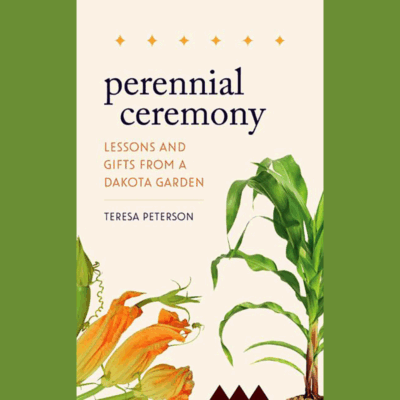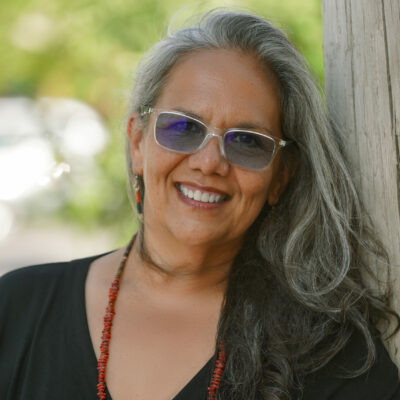Part One of Two
Teresa Peterson (Utuhu Cistinna Win) is author of the award-winning Perennial Ceremony: Lessons and Gifts from a Dakota Garden. She is Sisseton Wahpeton Dakota and a citizen of the Upper Sioux Community, located in what is now Minnesota. Teresa recently began serving as an Indigenous Advisor to the Climate Land Leaders Initiative. Here she answers (in bold) questions from that organization’s director, Teresa Opheim, on land stewardship from an Indigenous perspective.
Your book is organized by seasons: Wetu (Spring: The time of blood), Bdoketu (Summer: The time of the potato), Ptaƞyetu (Fall the time of the otter), and Waniyetu (Winter: The time when the snow lives). I love how the Dakota language describes the seasons. What are some other examples of how the Dakota Language is particularly descriptive in naming land and the relationships on it?
Yes, the Dakota language is so descriptive. In fact, contrary to the English language, Dakota is primarily verbs and fewer nouns, so very active and of course relational. Often, place names describe the relationship we have or have had with that particular place. For example, the community I am from – the Upper Sioux Community is called Pejuhutazizi (sometimes spelled Peżihutazizi) K’api and translates as the place where they dig the yellow medicine. Another Dakota community just down river is the Lower Sioux Indian Community. Their original Dakota name is Caηṡayapi – where they paint the trees red. Minnesota’s name – Mni Sota Makoce – is the land of cloudy waters (sometimes translated as land where the waters reflect the skies).
There are numerous towns throughout Mni Sota Makoce whose origins are from the Dakota language – a clear indicator that these are Dakota homelands. Chanhassen is Caηhasaη – which refers to the sugar maples; Mahtomedi is Mato Bde – Bear Lake; Minnetonka is Mni Taηka – Big Water and many more. There are some great resources out there to learn some of the Dakota language, history, and culture; for example, Dakota Wicoḣaη.

What is another Earth care concept that is particularly well conveyed in the Dakota language?
Besides having cultural, historic, and political connections to the land, the Dakota have a spiritual connection that can be best understood from the phrase Mitakuye Owasiƞ. It means all my relations. It’s the foundation to our way of life and is commonly said at the end of a prayer and can be a prayer in of itself. The Dakota have long understood the interconnectedness between all things. The animal and plant nations, the water, land, you and me, we all come from Wakaƞ Taƞka – the great mystery, or some may say taku skaƞ skaƞ (that which has movement, referring to the sacredness within). Thus we are all relatives. Christianity would say we’re all God’s children, everything is created by God. I believe science explains this concept through quantum physics. That there is a connection between all things, despite distances and thus our actions do matter. We are part of a larger system where everything is connected. This is understood through that common analogy of a spider web that demonstrates interconnection, interdependence, and the action on one strand is felt throughout its system. We have to ask ourselves: If everything is a relative, what decision shall I make and what action shall I take?
If one centers land as a relative, how do we treat it differently than we do?
There are some obvious things we as a society can change, much of it already dictated by laws and policies that unfortunately get overrun by greed. For example, why are there still violations in toxic dumping? I remember in grade school learning about the water cycle. The water is all the same, just cycling through various stages. We simply cannot afford pipelines breaking near water aquifers, rivers, or bodies of water. We cannot push freshwater sources into oceans due to flooding because we keep tiling out the rain water from prairie potholes and low lying farmlands. Microplastics, forever chemicals (PFAS), and toxins like nitrates are impacting the lands and waters, of which we are not separate from.
But sometimes thinking at a societal or global level can be daunting. When I’m feeling down about the state of things, I try to narrow my focus on what [my husband] Jay and I can do on our little six acres. I will ask myself, what do I have control over? So, we garden and do some foraging. We enjoy the foods that we grow and love to share or cook for friends and family. We compost, collect rainwater, recycle, those kinds of things. Lately we have been working on clearing invasives from the land and are excited to see what emerges. We’ve also been planting prairie plants and grasses and having prescribed burns to try to restore the land to what it used to be.
One of the things I strongly advocate for is to simply slow down and notice what is around you. Some call it nature bathing, but just get outside, unplug, and use all your senses to appreciate what is around you. Watching ant colonies is fascinating, listening and identifying bird songs, laying on the ground to take in the immense sky, hiking to a water source. Nature is limitless and always changing. There is a lot of literature out there that describes the mental and physical benefits — I would add spiritual as well – to being in nature. I think when we can do this, we appreciate what is around us, which might just be a better motivator for us to be a good relative.
If the serviceberry bush and the hummingbird, for example, are our relatives, then how do you manage for relatives you’d rather see less of (like the gopher in my garden)?
That is definitely a tricky dilemma and one that we are quite familiar with. I love that we share the trails with the deer, and it’s entertaining to watch the rabbits tease our canine companion. But I’m not too happy when they mow down my row of peas, just as they’re blossoming or see the tops of my peppers chomped off, the ones I’ve nurtured from seed months ago. My dad used to chuckle at my frustration and said many times, “Yea deer, they like a variety of things.” Then he helped me put up an electric fence that helped some for a number of years. But the rabbits continued to wiggle underneath. I even found them jumping into my raised beds to eat the carrot tops off. I started putting pieces of fencing over the bed and that helped. We’ve encircled our peppers with chicken wire to deter the deer and that seems to help. It is certainly a trial and error process for us, and we don’t always get it right.
Once, we had a mole, or more likely a colony of moles, in the garden. We used what we knew – mole bait that is intended to kill them. It didn’t seem to work and after some research, we tried vinegar, which is much less harmful, and that did the trick. Go figure! As for those persistent deer and rabbits, perhaps later in the year, one will find themselves at our dinner table and we’ll be full of gratitude and smile because we know they ate a healthy diet.

When you moved to your land near Mni Sota Wakpa (the Minnesota RIver), how did you go about investigating its history? Have you changed your care of the land based on that investigation?
It’s been 20 years or so now that we’ve been here on the bluff of the Mni Sota Wakpa. One of the things I did was read the title to the land, seeing how it changed hands, the acreage decreasing, parts being sold off from the original homestead that ultimately was created from Dakota treaty lands. I had already done research, learned from my uncle and other elders, the history of Mni Sota Makoce, so I understood how homesteads were created at the expense of Native Nations. I also drew from the writings of my great-grandfather, a white man who married into our Dakota family, who candidly told of how the Dakota were treated and swindled from their homelands. This understanding provided me with deep reverence and belongingness to this space. There are a lot of resources available to people, including those written by Native peoples on the horrific history that has led to the loss of our homelands. I’m more encouraged today than ever that our future decision makers and leaders will learn a more accurate and comprehensive history of so-called United States and Minnesota. To learn more, visit Indigenous Education for All.
The other kind of personal land query has been by spending time on the land. We planted a garden that has expanded over time and is now decreasing as we age and incorporate perennials, including those Native to the prairie. Over time, as we walked the deer trails that meander through the woods and down the hillside to the creek, they became deer and people trails. We cleared a little spot that overlooks the creek below that provides a quiet space for reflection and working through life’s problems. We would spot various hues of flowers and become curious to what they were. We discovered wild grape, wild plum, and gooseberries on the land as well. Uncovering the land’s gifts increasingly led to identifying Native and invasive species.
Over time and through various networks, witnessing others’ experiences, and combing through literature, we learned that prescribed burns are helpful in the restoration of prairie. A few years ago, we hired a small business to bring a herd of goats out who joyously ate down buckthorn and everything else enclosed in the temporary fence. More recently, we have begun to hand remove invasives to assist in the land’s restoration. So, it definitely is an evolving process that requires patience, inquiry, hard work, lots of faith, and the commitment to being a good relative to the land.
The joy that your land brings you comes out so strongly in your book. To what extent does this focus on gratitude reflect your Indigenous perspective?
When I think of gratitude, I think of my grandma and my mom. Both exemplify wobdiheic’iya or some would use the word wi’haha, that is, having a positive mindset. I think this comes from always looking for the good and being grateful. They have definitely influenced how I see the world. Not that I don’t get discouraged from time to time but I do try to look for what’s satisfying in this world. And gosh, there is so much goodness that the land does for us – from nourishing our bodies and minds, to offering space for reflection and refuge.